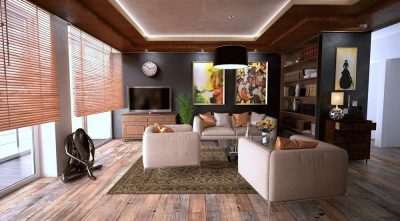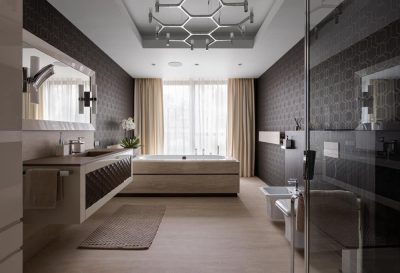
Great interiors don’t just look good – they sound good too. The hush of a living room, the soft thud of footsteps, the absence of echo on a work call: these are design choices, not accidents. With a few acoustic design tricks, you can shape how your home feels as much as how it looks. You don’t need recording-studio panels to tame household noise. With the right mix of materials, layout and a few clever swaps, you can dial down the din and dial up the calm.
From your home’s flooring to zoning ideas and decor choices, let’s take a look at what you can do to make your home feel quieter, cosier and more comfortable to live in.
Understanding home acoustics (without the physics headache)
Think of sound like water in your rooms: it can be soaked up, broken up, or kept from leaking between spaces. You don’t need formulas, just the basics. Think soft, thick things to hush noise, textured surfaces to stop echoes from bouncing around, and a few smart barriers to keep sound from travelling where it shouldn’t. You’ll mix all three across floors, walls, ceilings and furniture. Here are a few quick examples to keep in mind:
- Absorption: upholstery, curtains, rugs, felt, cork, acoustic plaster, fabric-wrapped panels.
- Diffusion: bookshelves, slatted timber, textured plaster, plants.
- Isolation: door seals, solid-core doors, heavy rugs, soft bumpers on furniture, rubber feet under appliances.
Blend a little of each in the same room and you’ll hear the difference fast: fewer echoes, softer footsteps, and conversations that stay where they’re meant to.
Flooring to set a quieter baseline
Flooring is the biggest soundboard in any room, so start here if you can. Hard, continuous surfaces are practical but they can reflect sound. For a calmer feel, hybrid flooring is a smart choice. It’s easy to clean and live with, and the built-in acoustic backing helps soften footfall and everyday noise, so rooms feel less echoey from the start.
Want it even quieter? Add a rug in living zones and a runner in hallways to absorb the chatter of footsteps. Go for wool or a dense flatweave, size up so the front legs of sofas and chairs sit on the rug, and use a quality underlay for more sound-soaking and less sliding. In long corridors, run the runner close to full length with a little breathing space at each end to tame those late-night footfalls. Finish the job with felt pads under chair and table legs so movement is a hush, not a tap.
Ceilings that soften, not shout
The ceiling is often wasted acoustic real estate. A dead-flat, shiny plane throws sound straight back at you, which is why long rooms can feel clattery. The solution? Keep ceilings low sheen so they don’t bounce glare or noise. If you’re renovating, subtle texture or linear detail (think shallow battens or timber slats with an acoustic layer behind) breaks up reflections without turning the room into a feature wall overhead. Over a dining table, a simple ceiling treatment paired with a fabric-shaded pendant creates a bubble of conversation that doesn’t leak to the next zone.
Décor choices that hush a room (and still look good)
Soft, substantial fabrics are your friends, so adding items made from bouclé, wool blends, textured linen and dense weaves absorb the higher frequencies that make rooms feel “hard.” Cushions and throws aren’t just pretty; they interrupt reflections right where you sit and talk. On the walls, canvas or fabric hangings take the edge off; if you love framed art, non-glare glazing avoids that sharp ping you get from bare glass. A bookcase with some open space and a mix of vertical and horizontal stacks acts as a natural diffuser, breaking up echoes without looking “acoustic.” These small touches might seem decorative, but they’re actually part of effective acoustic design tricks that balance style and serenity.
Taming the loud zones: kitchens and bathrooms
Hard surfaces, running water and constant traffic make these rooms naturally echo-prone, but you can stack small softeners that add up fast. A bit of textile underfoot, quieter hardware, and a few material choices that take the edge off without changing how the space works. Here’s how to calm each one.
The quiet kitchen (yes, really)
Kitchens are noisy by nature with lots of hard surfaces, clink and clatter, but there are a few ways to soften the soundtrack. Add these to your kitchen and you’ll hear the difference within a day:
- Washable runner by the sink: this softens footfall and clinks, and it grabs those drips so the floor stays safer and quieter.
- Soft-close hinges on doors/drawers: a small hardware swap that kills the slam and makes everyday use sound smoother.
- Upholstered bar stools: fabric absorbs chatter and takes the edge off scraping noises.
- Fabric roman blind: adds a soft layer at the window to calm hard-surface echo during meal prep.
- Slatted island or banquette with acoustic backing: the slats break up reflections; a hidden felt or insulation layer behind them actually soaks up sound.
Bathrooms that don’t echo
Echo is common in bathrooms, as tiles, glass and porcelain bounce every sound. Fortunately a couple of soft layers and small fixes can hush the room fast:
- Dense bath mat: this will cushion footsteps and absorb splash noise so the room sounds softer underfoot.
- Linen or cotton curtains: adds a gentle fabric layer that takes the edge off tile bounce while keeping things light.
- Matte or timber-framed mirror: reduces harsh reflections so the space looks and sounds less “hard.”
- Soft bumpers on vanity doors/drawers: stops the late-night thud and makes everyday use feel quieter.
- Towels as sound absorbers: stack a couple on a rail or hook to act like mini acoustic panels without looking technical.
Zoning open-plan spaces without walls
Open plan looks amazing in photos, but in real life sound can ping around. The trick is to carve out quieter pockets without building anything. Group materials by zone: a wool rug under the sofa, a fabric-shaded pendant and a low-sheen ceiling over the dining table, and sheers across big panes so chatter does not slap back into the room. Each choice marks out a “soft” area where noise lands and stays.
Also, don’t forget the power of dividing up the space. By adding features like tall plants and bookcases, you create friendly room dividers that will interrupt direct sound paths and still let the space feel connected. Keep walkways clear and avoid lining up hard furniture edges into a narrow corridor, because footsteps get louder in tight passes. A little spacing, a little softness and suddenly the whole plan feels calmer.
A calmer home isn’t about soundproofing everything, it’s about layering small choices that work together. Start with the big canvases like your floors and ceilings, soften the kitchen and bathroom, and use zoning tricks in open plans so any noise has places to land. Mix absorption, diffusion and a bit of isolation, and keep tweaking until the room sounds as good as it looks — that’s the real magic behind today’s best acoustic design tricks.








